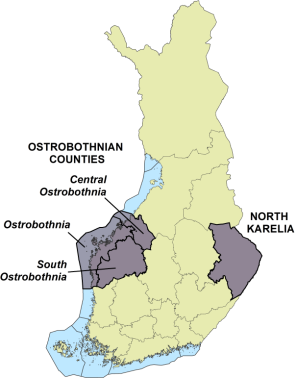In close collaboration with stakeholders representing societally-relevant systems, the project has co-produced scenarios for two regions of Finland based on the global framework of shared socioeconomic pathways (SSPs). The scenarios, focused on the 2050s, are for three contiguous counties of Ostrobothnia (South Ostrobothnia, Central Ostrobothnia and Ostrobothnia) in western Finland, and for the county of North Karelia in eastern Finland. They combine SSP-based regional socioeconomic narrative extensions with regional climate projections that use results of CMIP6 global model simulations. Application of the scenarios has been demonstrated through the co-development of adaptation-stories, which are fictional accounts, set in the future, describing local experiences of how different individuals have adapted to changing climate. The adaptation stories are based on projected impacts, SSP-based narratives and interviews with locally-relevant stakeholders.
FINSCAPES scenarios for North Karelia
Scenario summary for North Karelia
Socioeconomic narratives
Four SSP-based socio-economic narrative extensions are presented here for North Karelia in the 2050s. They were created in collaboration with local stakeholders, to assist in climate change analysis and adaptation planning. These are summary versions in English. Each SSP extension is preceded by a visual and personal interpretation of the narrative by local artist Sanna Hukkanen.
SSP1 Sustainability – Taking the Green Road
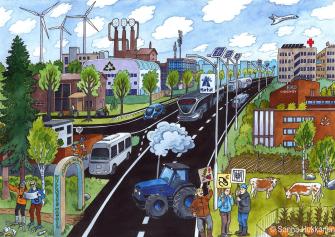
Sustainable development in North Karelia is promoted through education and research. Societal change is built on social justice. Regional cooperation is increasing and demand for ecological products growing, while consumption is being channelled in a sustainable direction. Sustainable lifestyles and better access to nature increase citizens' health and well-being. Joensuu’s role as the European Forest Capital is strengthening the region's contribution to the green transition. However, there is some resistance to change and conflicts do still occur.
There is strong economic growth built on the green transition, creating new business opportunities. North Karelia is a prominent player on the international stage and produces experts who are highly qualified in the sustainability transition. The profitability of livestock farming has suffered, but it remains an important part of food security and helps maintain biodiversity. Organic and local food production is increasing, as is the utilisation of forests for harvesting natural products. There are growing job opportunities in the bioeconomy sector.
North Karelia utilises bioenergy, alternative energy products and energy storage solutions. Technological development supports the optimisation of sustainable energy distribution and the use of smart technologies. The use of renewable energy, such as wind and solar power, is increasing, but it brings with it challenges in land use and creates conflicts with biodiversity protection. The rising cost of fossil fuels is causing energy poverty for some parts of the population.
Sustainable forest management and biodiversity conservation are highly valued. Recreational use of forests and the availability of ecosystem services are on the increase. The condition of forests and water bodies is improving, supporting biodiversity conservation and improving overall environmental quality. However, an increase in nature tourism is leading to restrictions on “everyone’s rights” access in order to protect sensitive biotopes.
SSP3 Regional Rivalry – A Rocky Road

North Karelia faces significant challenges as international trade and cooperation collapse. Regional centres are shrinking and wealth is increasingly concentrating in cities, deepening regional inequalities. Confrontation, distrust and xenophobia are becoming more common in society, while the role of local community structures is becoming more important. Traditional lifestyles are gaining popularity.
A decrease in the use and availability of international expertise is leading to a decline in the overall level of knowledge. The procurement of skilled labour is becoming increasingly difficult. Exports are collapsing and the region's economic structures are coming under increased pressure. On the other hand, efforts are underway to maintain cooperation between various sectors and organisations. Bioenergy and forestry offer some relief from the economic challenges, but the fragmentation of economic structure requires restructuring and innovation, which is difficult to achieve in the prevailing situation.
North Karelia is striving to utilise local bioenergy reserves and hence strengthen Finland's energy security. The difficult economic situation and lack of raw materials is contributing to a growth of the circular economy. The region's isolation and economic decline are reflected in neglected and deteriorating infrastructure as there is little investment in its upkeep.
The intensive use of natural resources continues while a weakening of environmental protection is leading to a loss of biodiversity. National parks and protected areas have either been closed or their protections weakened. The value of natural products is increasing, but they have become luxury products due to their growing scarcity. The recreational use of nature is declining and people’s connection with nature is weakening. The health of the population is deteriorating due to an increase in lifestyle diseases and shorter life expectancy. An ageing population and shrinkage of younger age groups is putting a strain on elderly care and public finances.
SSP4 Inequality – A Road Divided
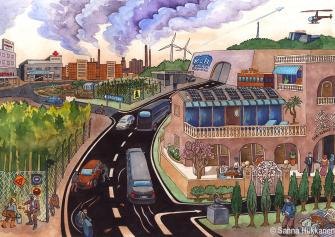
In an increasingly unequal world, North Karelia is also suffering from rising inequality. Power and wealth are increasingly concentrated in the hands of the few, while access to education is becoming increasingly unequal. Healthcare provision is polarising, with lifestyle diseases becoming more common in poor areas, while the wealthy enjoy high quality services. Rural areas are suffering from depopulation as urbanisation accelerates. Social tensions are rising as people perceive weakening opportunities to influence their own lives. Trust in society is declining among a large majority of citizens, while feelings of insecurity are growing.
Multinational companies are carving out space for themselves in a volatile operating environment. With rising inequality, jobs and vitality are becoming concentrated in large population centres. Low-paid work is on the increase. Crime rates are growing with rising economic distress. Forestry remains an important economic activity, but its benefits are unevenly distributed. Food production is concentrated on large intensively cultivated farm units.
Rural depopulation is eroding transport services and infrastructure in the countryside. Technological development is high in some sectors. For example, progress has been made in improving water quality of waterways, leading to an increase in clean water supplies. Energy prices are high relative to the income levels of most people. Household energy needs are met by bioenergy. Remote and digital services are addressing some of the lack of service provision, especially in rural areas.
Environmental degradation and species extinction are accelerating as economic factors outweigh sustainability considerations. The intensive exploitation of forests continues, leading to both social and ecological consequences that deepen regional divisions. Environmental crime is on the increase due to the high expense and inadequacy of waste management. Nature tourism has become a pastime mainly for the wealthy.
SSP5 Fossil-fuelled Development – Taking the Highway

The development of North Karelia is based on the use of fossil fuels, which together with a strong forestry sector supports the economic vitality of the region. Society benefits from energy intensity, which enables widespread consumption and strengthens the economy. Lifestyle diseases associated with overconsumption place a strain on health care. This is being addressed, for example, through the privatisation of healthcare. Natural values and sustainable activities are being neglected as people become alienated from nature.
Food production is concentrated on intensive production, with less attention paid to quality. The market determines food prices and choice. Forestry is a key industry and forests are used intensively. Joensuu is known as the forest capital of Europe, and produces top experts in the forest sector. The region’s mining industry is also expanding as consumption grows and technology develops. Energy and raw materials are inexpensive.
The forests of North Karelia support Finland's energy security as a source of bioenergy, even though imported fossil fuels are the main source of energy. Technological progress has reduced energy consumption and improved the efficiency of fertiliser use in food production. Agriculture also utilises renewable energy and new crops and vertical farming are proliferating. The telecommunications infrastructure is of high quality and offers fast connections, which is improving opportunities, for example for remote working. This enhances the availability of skilled labour in many sectors.
Intensive use of fossil fuels is degrading the quality of the environment and increasing ecological stresses. Nature conservation priorities are overshadowed by economic growth. The fossil energy sector exploits forest-based bioenergy as a tool for greenwashing. Waterways suffer damage from peat production and intensive monoculture farming. This leads to conflicts between conservationists and the forest industry. Small areas (bubbles) of protected environment mainly provide highly commercialised experiences of nature for the public.
Regional climate projections
Regional climate projections for North Karelia can be found on the FINSCAPES webpages at the Finnish Meteorological Institute.
Adaptation stories for North Karelia
These are fictional stories, set in the year 2050, that shed light on the experiences and solutions of local people, reporting how they have adapted to the challenges and opportunities created by climate change. The stories offer perspectives on the adaptation of milk production. They describe how milk producers and buyers have managed to maintain the health of livestock and milk production during the warming summers. Here we present excerpts of two adaptation stories from the perspective of the same dairy farming couple, Niilo and Venla Nevalainen, from Lieksa. They are set in two alternative future socioeconomic contexts, based on the SSP1 and SSP4 narratives.
Each story is complemented by a visual interpretation by an artist from North Karelia, Anne Stolt. Full stories will be provided following their publication in the scientific literature.
SSP1 (Sustainable world): The farm is adapting to climate change by combining tradi-tional expertise with technological innovations
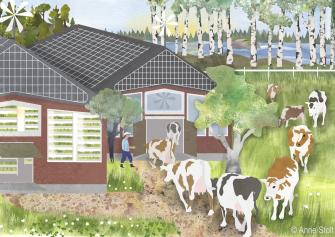
…But back to the present. The cows that grazed outside during the night are now queuing their way back to the barn. It’s certainly more comfortable inside, where the automated system adjusts ventilation based on the temperature. This ensures the cows have the best possible conditions during the hottest parts of the day. Fortunately, electricity prices in Finland have remained reasonable, so all the technology we use doesn’t cause extra worry. After all, as the newspapers have written, Finland has managed to stabilise electricity prices by investing over the decades in renewable and self-sufficient energy production…
SSP4 (Unequal world): Locality is favoured and self-sufficiency strengthened on the farm
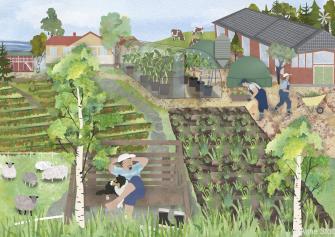
...When the local dairy farms began shutting down, multinational companies started appearing in the area. They aggressively sought to make contracts with local milk producers. While these new players bring stability and jobs to the region in these uncertain times, Venla and I didn’t want to get involved in that. Profitability tends to decline even further when working with multinational companies, and their operations often leave much to be desired in terms of ethics. Most of the remaining farms here have become large-scale intensive production units. However, we wanted to focus on socially and environmentally sustainable dairy farming. That’s why we made a contract with a local dairy, which produces high-quality products. Especially during holiday seasons, well-off people from the cities come here who are willing to pay for cleanly produced food and quality services...
FINSCAPES scenarios for the Ostrobothnian counties
Scenario summary for the Ostrobothnian counties
Socioeconomic narratives
Four SSP-based socio-economic narrative extensions are presented here for the Ostrobothnian counties in the 2050s. They were created in collaboration with local stakeholders, to assist in climate change analysis and adaptation planning. These are summary versions in English. Each SSP extension is preceded by a visual and personal interpretation of the narrative by local artist Ilpo Koskela.
SSP1 Sustainability – Taking the Green Road
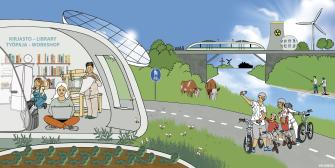
A just green transition is pursued through strong institutions and regulation. The Ostrobothnian counties support small-scale entrepreneurship while the use of natural resources is regulated in line with needs for environmental protection. Interest in self-sufficiency and sustainable lifestyles are increasing thanks to efforts in education and awareness-raising. A strong circular economy assists in meeting the challenges of the green transition. Residents teach and learn traditional and self-sufficiency skills. This increases resilience to confront change and preparedness for crisis situations.
The state uses taxation to drive sustainable choices, for example, making healthy food and exercise more accessible. Reducing work and consumption improves the quality of life. Urbanisation continues, though rural living is better supported by decentralised energy solutions and advanced telecommunications infrastructure. However, inequalities still exist in the population.
The Ostrobothnian counties are at the forefront of the green transition, creating networks and new business opportunities. Consumption of raw materials and waste is reduced by the circular economy. A decline in meat consumption has led to changes in the food industry while vertical farming and artificial meat production are creating new opportunities. Local food is produced by community-supported agriculture as well as by cooperatives . Tourism is another important source of income for the region.
The Ostrobothnian counties become net exporters of energy. Energy production is decentralised and utilises various energy sources. Technological development supports renewable energy production. New energy ecosystems and storage facilities assist in smoothing out peak demand. The region’s globally recognised industrial research and development produces sustainable solutions. Urban areas are structured sustainably supported by public transport and cycling infrastructure, while rail lines link different economic areas.
Biodiversity is both valued and protected, while cultural landscapes are important for tourism. Land use is changing due to the green transition, which also affects changes in traditional landscapes. Environmental protection leads to increased recreational use of nature, though there are also concerns about impacts of overcrowding on the sustainability of fragile natural areas.
SSP3 Regional Rivalry – A Rocky Road
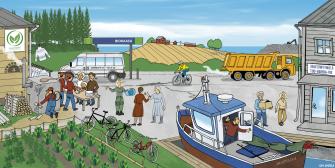
As international cooperation and trade collapse, the Ostrobothnian counties are increasing their mutual cooperation. Rural populations have declined, though urbanisation is slowing as urban life is becoming more expensive. People are turning to car-pooling and other means of transport as public transport is declining, especially in rural areas, and private cars are expensive. The quality of health care is deteriorating due to falling tax revenues and a lack of doctors. The level of education is falling, while practical skills and self-sufficiency are becoming more important. Inequalities will increase with the weak economic situation, leading to unrest and mistrust. At the same time, however, the importance of village communities is growing.
As international trade is stagnating, the economy is weak and innovation is declining. International trade is conducted mainly with other Nordic countries. Reduced business opportunities are partly compensated for by circular and exchange economies. The availability of skilled labour is declining and of foreign labour is scarce. Agriculture is weakened by reduced EU subsidies and scant resources. Meanwhile, self-sufficiency through small-scale farming and fishing is emphasised as food prices are high.
Energy production relies on domestic sources as imported energy is expensive. All energy production resources have been mobilised. Local energy solutions – such as wood, peat and the use of biogas – are increasing. Maintaining infrastructure is a challenge in the absence of economic growth, resulting in the deterioration of infrastructure in remote areas. Though maritime transport is shrinking, small marinas are doing well as locals supplement their livelihoods through fishing.
The intensive use of resources leads to environmental damage and biodiversity loss. Forests will be converted into plantations and recreational use of nature is reduced. At the same time, nature has become a resource to supplement livelihoods as the importance of natural food gathering increases. Despite the general decline in nature-based values, rural dwellers are interested in maintaining biodiversity to support self-sufficiency.
SSP4 Inequality – A Road Divided
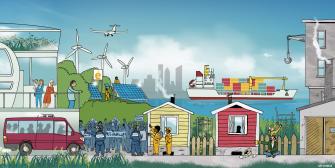
Inequalities are growing in the Ostrobothnian counties and are reflected, for example, in residential areas: urbanisation is accelerating and rural areas are becoming deserted as services are concentrated in cities. High levels of inequality cause instability and unrest, increasing feelings of insecurity. Education is of a high standard but largely inaccessible to the poor. Power and influence are thus increasingly concentrated among the wealthy. Nevertheless, public, private and third sector cooperation is pursued to promote well-being.
Energy technology is an important export product and the region is renowned for its expertise on the subject. Clean energy and digitalisation have made the economic fabric of the regions sustainable. The supply of skilled foreign labour is making up for local skills shortages. Many smaller arable farms have ceased operations and been replaced by large intensive farms. Home gardening is an important addition to many people’s livelihoods.
Technological advances are enabling, for example, carbon capture and wind-powered hydrogen production. There is co-operation in energy production between rural and urban areas. However, infrastructure investment is concentrated in export-oriented and wealthy regions. Ports are becoming increasingly important as freight transport increases, even though passenger transport is on the decline. Public transport use is increasing, though it primarily serves the transport needs of people on low incomes.
Intensive exploitation of natural resources is leading to the fragmentation of forest areas and the degradation of green spaces. Recreational use of nature is mainly targeted at the elite, while the less well-off have limited access to nature. The environmental impacts of food production are increasing. Meanwhile, low-income populations forage for food in nature as food prices rise.
SSP5 Fossil-fuelled Development – Taking the Highway
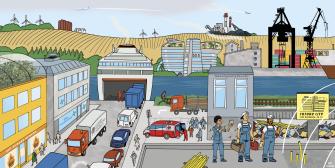
The world runs on fossil fuels and is dependent on high technological development. Efforts are being made in the Ostrobothnian counties to share the fruits of economic growth equally, though inequalities still exist. Natural resources are exploited intensively, with sustainable development values taking a back seat, causing conflicts between different parts of the population. Urbanisation is increasing as the population grows . Driving is cheap, which leads to reduced public transport in rural areas. However, technology is being used to develop comprehensive 'Mobility-as-a-Service' platforms. Health services are becoming more commercialised and inequitable, while lifestyle diseases are on the rise due to unhealthy diets.
Economic growth, boosted by fossil fuels, supports business investment and market predictability. The energy sector is particularly strong. However, the sharp fall in demand for renewable energy is undermining the prospects for companies specialising in this sector. Labour mobility is high globally, with competition for skilled labour fierce. Food production is strongly driven by international markets. New food production technologies combined with clean production methods have become an important export product for the Ostrobothnian counties.
Advanced energy storage solutions have been widely adopted. Technological developments have also made it possible to capture and further process carbon dioxide emissions. Although fossil fuels are widely used, renewable energy sources are still supported. Infrastructure development focuses on the needs of road transportation, making freight transport efficient and effective. Rail transport development is limited. Port infrastructure is improved to keep up with increased shipping traffic.
The use of fossil fuels and the intensive exploitation of natural resources degrade the quality of the environment. Insect pests and plant diseases are spreading rapidly in monocultures. Intensive agriculture and increased shipping traffic put pressure on waterways and marine areas. Recreational opportunities in nature are being reduced through the overconsumption of resources. Environmental degradation is affecting people's relationship with nature. Technological progress is mitigating some environmental challenges and ensuring, for example, access to clean drinking water.
Regional climate projections
Regional climate projections for the Ostrobothnian counties can be found on the FINSCAPES webpages at the Finnish Meteorological Institute.
Adaptation stories for the Ostrobothnian counties
Adaptation stories are fictional narratives, set in the future, describing the local experiences of different people on how they have managed to adapt to climate change. A real-world healthcare example is the planned renovation of Seinäjoki hospital in South Ostrobothnia. Based on surveys, discussions and the results of a thesis, stories were created from the perspectives of hospital staff and patients. These aim to illustrate and inspire thinking about how the hospital complex could be adapted to the impacts of a likely warmer and wetter climate in the region. The stories will be presented here following their publication in the scientific literature.
FINSCAPES final seminar
The FINSCAPES Final Seminar, held in Helsinki and virtually on 24 October 2024, presented the project's research results and discussed their implications for climate change adaptation planning and practice.
Presentations
- Timothy Carter: Introduction to FINSCAPES (pdf, 882.47 KB)
- Sari Koivula: North Karelia (pdf, 1.01 MB)
- Irina Nori: Ostrobothnian counties (pdf, 966.72 KB)
- Anna Lipsanen: SSP-based regional socioeconomic narratives (pdf, 3.52 MB)
- Kirsti Jylhä, Petri Räisänen & Laura Utriainen: SSP-based regional climate projections (pdf, 5.78 MB)
- Karoliina Rimhanen & Nina Pirttioja: Climate- and adaptation-stories (pdf, 2.18 MB)
- Timothy Carter: Integrated regional scenarios (pdf, 1.36 MB)
- Heikki Lehtonen: Scenario demonstration: Quantifying agri-food SSP-RCPs (pdf, 1.82 MB)
- Reija Ruuhela: Demonstration projects: Urban growth scenarios in a changing climate (pdf, 2.4 MB)
Publications
FINSCAPES infosheets
- FINSCAPES Info 1/2021 FINSCAPES: Finnish scenarios for climate change research. Addressing policies, regions and integrated systems (pdf, 317.09 KB)
- FINSCAPES Info 2/2022 FINSCAPES project begins to construct scenarios for climate analysis (pdf, 250.11 KB)
- FINSCAPES Info 3/2024 FINSCAPES project finalises a new set of integrated regional scenarios for climate change analysis (pdf, 381.59 KB)
- Infosheets in Finnish
- Infosheets in Swedish
Overview/Methods
- Green, C., S. Fagerström, D. Ke, P. Metzinger, M. Myllynen, X. Xing, T.R. Carter, K. Ebi, M. Garschagen, K. Kok, A. Lipsanen, K.Takahashi, B. J. van Ruijven. 2022. Shared Socioeconomic Pathways (SSPs) Literature Database, Version 2, 2020-2021 (Preliminary Release). Palisades, NY: NASA Socioeconomic Data and Applications Center (SEDAC). https://doi.org/10.7927/vtsk-hf73. Accessed 12 December 2023.
- Ruuhela, R., Carter, T.R., Rantanen, M., Polade, S., Lipsanen, A., Jylhä, K., Laurila, T.K., Luomaranta, A., Fagerström, S., Luhtala, S., and Gregow, H. 2023. Ilmasto- ja sosioekonomiset skenaariot ilmastonmuutokseen sopeutumisen suunnittelussa (Climate and socioeconomic scenarios for climate change adaptation planning), Publications of the Ministry of Agriculture and Forestry 2023:4, Ministry of Agriculture and Forestry, 43 pp. (in Finnish with English summary). https://julkaisut.valtioneuvosto.fi/handle/10024/164670
Regional climate: observations and projections
- Ruosteenoja, K. and K. Jylhä, 2021. Projected climate change in Finland during the 21st century calculated from CMIP6 model simulations. Geophysica, 56, 39–69. (PDF)
- Ruosteenoja, K. and K. Jylhä, 2021. Online supplement for: Projected climate change in Finland during the 21st century calculated from CMIP6 model simulations. Geophysica, 56. 14 p. (PDF)
- Ruosteenoja K, 2021: Applicability of CMIP6 models for building climate projections for northern Europe. Finnish Meteorological Institute, Reports 2021:7., https://hdl.handle.net/10138/334477
- Toivonen E, Partanen A-I, Jylhä K, 2021: Ilmastonmuutos vaikuttaa hulevesien mitoitukseen Suomessa ja muissa Pohjoismaissa. Vesitalous 2/2021, p. 14–18. (PDF)
- Médus, E., 2022: Regional climate over Northern Europe: from observations to high-resolution modeling. Finnish Meteorological Institute Contributions 182. https://doi.org/10.35614/isbn.9789523361591
- Médus, E., Thomassen, E. D., Belušić, D., Lind, P., Berg, P., Christensen, J. H., Christensen, O. B., Dobler, A., Kjellström, E., Olsson, J., and Yang, W., 2022. Characteristics of precipitation extremes over the Nordic region: added value of convection-permitting modeling, Nat. Hazards Earth Syst. Sci., 22, 693–711. https://doi.org/10.5194/nhess-22-693-2022
- Ruosteenoja, K., Jylhä, K. Average and extreme heatwaves in Europe at 0.5–2.0 °C global warming levels in CMIP6 model simulations. Clim Dyn 61, 4259–4281 (2023). https://doi.org/10.1007/s00382-023-06798-4
- Ruosteenoja, K. and Jylhä, K., 2023. Heatwave projections for Finland at different levels of global warming derived from CMIP6 simulations. Geophysica, 58. (PDF)
- Bracho-Mujica, G., R.P. Rötter, M. Haakana, T. Palosuo, S. Fronzek, S. Asseng, C. Yi, F. Ewert, T. Gaiser, B. Kassie, K. Paff, E. Rezaei, A. Rodríguez, M. Ruiz-Ramos, A.K. Srivastava, P. Stratonovitch, F. Tao and M.A. Semenov (2024) Effects of changes in climatic means and variability on future wheat and maize yields and the role of adaptive agro-technologies in reducing negative impacts. Agricultural and Forest Meteorology 346, 109887, doi:10.1016/j.agrformet.2024.109887
